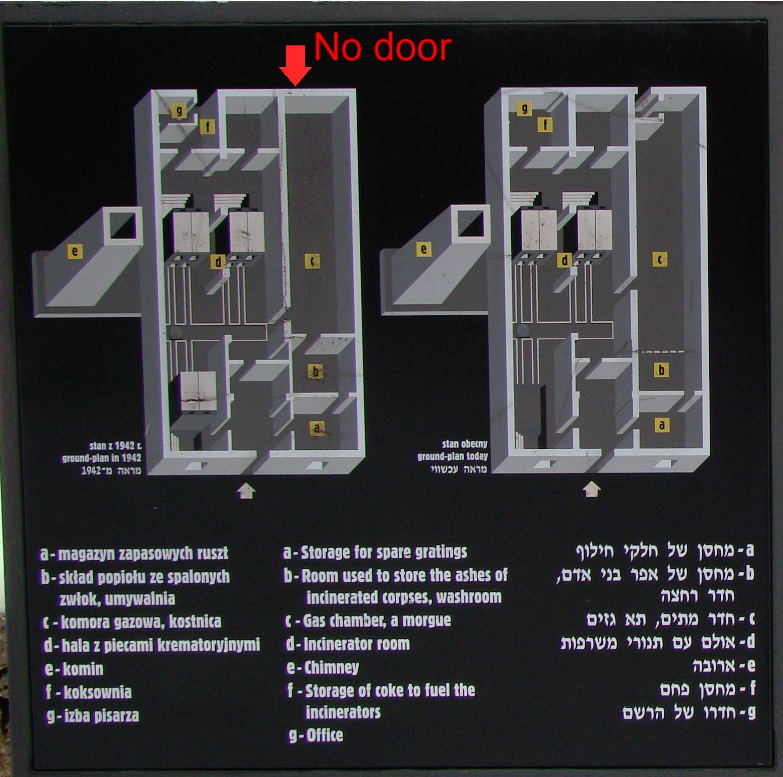British-Jewish journalist Thomas Harding
released his double-biography of his
great-uncle Hanns Alexander and former
Auschwitz commandant Rudolf Hoess in
late August 2013. It's not the first
double-biography in which Hoess has
featured, Ladislaus Kluz's Kolbe
and the Kommandant is
now thirty years old, but it's very
unlikely that received the media-hype
that Harding's book has been afforded.
In the book Harding writes of his visit
to the Auschwitz I camp in November 2012
accompanied by Hoess' daughter-in-law
Irene Alba and her son—Hoess'
grandson—Rainer Hoess. Harding describes
what happened when they were viewing the
the Polish built ammunition depot cum
German crematorium and morgue cum air
raid shelter (a building alleged to have
housed a homicidal gas chamber) in
Auschwitz I:
"Rainer walks over to a metal door
with a small hole in it. This is the
back door to the old crematorium. This
is where his grandfather looked through
the peephole and watched the prisoners
being gassed to prove to his staff that
he could cope with the mass murders
taking place under his watch." (p.285)
There's more than one problem with this
claim though. Harding is obviously
describing the door on the south-east
side of the building, one of only two
doors to the building, and the only
metal one containing a peep-hole. I was
at Auschwitz ten months prior to their
visit, and as shown in my photograph
below it was not possible for me to
approach this door due to a museum sign
blocking the path which read 'No
Entrance.'
Of course it's possible that this sign
held by metal chains was not there when
they visited, and if this was the only
issue I had with Harding's tale I would
not even be bothering to write about it.
It's Harding's claim that Rudolf Hoess
watched Jews being gassed through the
peep-hole in this door that is the real
issue.
Harding's clearly referring to something
written in Hoess' "memoirs":
“I had to look through the peephole
of the gas chambers and watch the
process of death itself, because the
doctors wanted me to see it. I had to do
all this because I was the one to whom
everyone looked, because I had to show
them all that I did not merely issue the
orders and make the regulations but was
also prepared myself to be present at
whatever task I had assigned to my
subordinates."
In this part of the "memoirs" "Hoess" is
just talking generalities, there is no
way to pin point which of the seven gas
chambers that were supposedly used in
Auschwitz I and Auschwitz II (Birkenau)
he's talking about, nor how many times
he looked through a gas chamber door
peep-hole. But we can be 100% sure that
he never once looked through the
peep-hole in the door Harding claims he
did, and this has nothing to do with
denying that this building was used as a
homicidal gas chamber either, even if I
accept for argument sake that 10,000
people were gassed in this building,
that doesn't change the fact that
according to the Auschwitz museum, and
two court recognised Auschwitz experts,
this door did not exist when gassing
occurred in this building. It was not
until the building was converted into an
air raid shelter in 1944 that this door
was created.
In Van Pelt's & Dwork's 1996 Auschwitz
1270 to the Present, they reproduce
a 1942
plan of the crematorium
and morgue (which they alleged was
converted into a gas chamber in
September 1941) on which Harding's door
is absent. In Pressac's 1989 Auschwitz:
Technique & Operation of the Gas
Chambers he reproduces
several German plans of the building,
from September
1941; October
1944; December
1944, and only on the plans from
1944 does this door appear, as these
plans were drawn after the September
1944 decision to convert the building
into an air raid shelter for the
patients and staff of the adjacent SS
hospital.
Pressac writes of
the passage way in the above photograph:
"The southeast access to the second
air lock of the air raid shelter for the
SS hospital ... This entrance led
directly to the former gas chamber of
Krematorium I. Though it had nothing to
do with the gas chamber it was preserved
during the restoration, whereas it
should have been filled in to respect
historical facts."
Harding has no excuses for his nonsense
story either, even if he hasn't read the
above mentioned books. Just yards away
from the door in question is the museum
sign below (red annotations are mine)
which states that that this door was not
present in 1942:



























.jpg)










Don't let accuracy get in the way of churning out more holo-porn which will no doubt be bulk bought by public libraries and end up as a school text book.
Reply"The author was accompanied by Hoess´ daughter in law and grandson, this must be true", might someone think who is not familiar with the stuff examined at this blog. Good work.
Reply